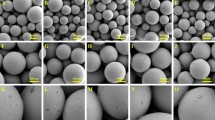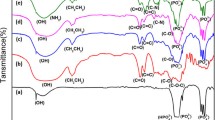Abstract
Purpose
The goal of this study was to exploit the multifunction of PLGA based microsphere as efficient alendronate delivery and also as potential injectable cell carrier for bone-repairing therapeutics.
Materials and Methods
Novel poly (lactic-co-glycolic acid) (PLGA)-hybridizing -hydroxyapatite (HA) microspheres loaded with bisphosphonate-based osteoporosis preventing drugs, alendronate (AL), are prepared with solid/oil/water (s/o/w) or water/oil/water (w/o/w) technique. Macrophage resistance was evaluated by MTT [3-(4,5-Dimethylthiazol-2-yl)-2,5-diphenyltetrazolium bromide] assay, DNA assay and Live/dead staining, and osteoblast proliferation and maturation was assessed by MTT assay, Alkaline phosphatase (ALP) activity assay and Real time-PCR.
Results
In such fabricated AL laden PLGA/HA microspheric composites (abbreviated “PLGA/HA-AL”), the introduction of HA component has been proven capable of largely enhancing drug encapsulation efficiency especially when the single emulsion protocol is adopted. The in-vitro drug (AL) releasing profile of PLGA/HA-AL system was plotted basing over 30 days’ data collection. It indicates a sustained releasing tendency despite a minimal burst at the very beginning. The in-vitro bone-repairing efficacy of PLGA/HA-AL system was first tested with macrophages that are identified as precursors of osteoclasts and potentially responsible for osteoporosis. The results indicated that the AL release significantly inhibited the growth of macrophages. Additionally, as a central executor for osteogenesis, osteoblasts were also treated with PLGA/HA-AL system in vitro. The outcomes confirmed that this controlled release system functions to improve osteoblast proliferation and also enables upregulation of a key osteogenic enzyme ALP.
Conclusions
By pre-resisting osteoclastic commitment and promoting osteoblastic development in vitro, this newly designed PLGA/HA-AL controlled release system is promoting for bone-repairing therapeutics.








Similar content being viewed by others

References
H. Fleisch. Bisphosphonates: mechanisms of action. Endocr. Rev. 19:80–100 (1998). doi:10.1210/er.19.1.80.
R. G. Russell, and M. J. Rogers. Bisphosphonates: from the laboratory to the clinic and back again. Bone. 25:97–106 (1999). doi:10.1016/S8756-3282(99)00116-7.
H. Shinoda, G. Adamek, R. Felix, H. Fleisch, R. Schenk, and P. Hagan. Structure–activity relationships of various bisphosphonates. Calcif. Tissue Int. 35:87–99 (1983). doi:10.1007/BF02405012.
E. van Beek, M. Hoekstra, M. van de Ruit, C. Lowik, and S. Papapoulos. Structural requirements for bisphosphonate actions in vitro. J. Bone Miner. Res. 9:1875–1882 (1994).
G. A. Rodan. Mechanism of action of bisphosphonates. Annu. Rev. Pharmacol. Toxicol. 38:375–388 (1998). doi:10.1146/annurev.pharmtox.38.1.375.
D. E. Hughes, K. R. Wright, H. L. Uy, A. Sasaki, T. Yoneda, G. D. Roodman, G. R. Mundy, and B. F. Boyce. Bisphosphonates promote apoptosis in murine osteoclasts in vitro and in vivo. J. Bone Miner. Res. 10:1478–1487 (1995).
A. Ezra, and G. Golomb. Administration routes and delivery systems of bisphosphonates for the treatment of bone resorption. Adv. Drug Deliv. Rev. 42:175–195 (2000). doi:10.1016/S0169-409X(00)00061-2.
S. Patashnik, L. Rabinovich, and G. Golomb. Preparation and evaluation of chitosan microspheres containing bisphosphonates. J. Drug Target. 4:371–380 (1997).
E. H. Nafea, M. A. EI-Massik, L. K. EI-Khordagui, M. A. Marei, and N. M. Khalafallah. Alendronate PLGA microspheres with high loading efficiency fro dental applications. J. Microencapsul. 24:525–538 (2007). doi:10.1080/02652040701439807.
A. Nieto, F. Balas, M. Colilla, M. Manzano, M. Vallet-Regí. Functionalization degree of SBA-15 as key factor to modulate sodium alendronate dosage. Microporous. Mesoporous. Mater. 2008 . doi:10.1016/j.micromeso.2008.03.025.
F. Balas, M. Manzano, P. Horcajada, and M. Vallet-Regi. Confinement and controlled release of bisphosphonates on ordered mesoporous silica-based materials. J. Am. Chem. Soc. 128:8116–8117 (2006). doi:10.1021/ja062286z.
X. Shi, Y. Wang, K. Wei, L. Ren, and C. Lai. Self-assembly of nanohydroxyapatite in mesoporous silica. J. Mater. Sci., Mater. Med. 19:2933–2940 (2008). doi:10.1007/s10856-008-3424-3.
K. Balani, R. Anderson, T. Laha, M. Andara, J. Tercero, E. Crumpler, and A. Agarwal. Plasma-sprayed carbon nanotube reinforced hydroxyapatite coatings and their interaction with human osteoblasts in vitro. Biomaterials. 28:618–624 (2007). doi:10.1016/j.biomaterials.2006.09.013.
B. Palazzo, M. Iafisco, M. Laforgia, N. Margiotta, G. Natile, C. L. Bianchi, and D. Walsh. Biomimetic hydroxyapatite-drug nanocrystals as potential bone substitutes with antitumor drug delivery properties. Adv. Funct. Mater. 17:2180–2188 (2007). doi:10.1002/adfm.200600361.
J. Schnieders, U. Gbureck, R. Thull, and T. Kissel. Controlled release of gentamicin from calcium phosphate-poly(lactic acid-co-glycolic acid) composite bone cement. Biomaterials. 27:4239–4249 (2006). doi:10.1016/j.biomaterials.2006.03.032.
H. Nie, and C. -H. Wang. Fabrication and characterization of PLGA/HAP composite scaffolds for delivery of BMP-2 plasmid DNA. J. Control. Release. 120:111–121 (2007). doi:10.1016/j.jconrel.2007.03.018.
E. Boanini, P. Torricelli, M. Gazzano, R. Giardino, and A. Bigi. Alendronate-hydroxyapatite nanocomposites and their interaction with osteoclasts and osteoblast-like cells. Biomaterials. 29:790–796 (2008). doi:10.1016/j.biomaterials.2007.10.040.
K. Park, J. S. Park, D. G. Woo, H. N. Yang, H. M. Chung, and K. H. Park. The use of chondrogenic differentiation drugs to induce stem cell differentiation using double bead microspheres structure. Biomaterials. 29:2490–2500 (2008). doi:10.1016/j.biomaterials.2008.02.017.
G. E. Rooney, C. Moran, S. S. McMahon, T. Ritter, M. Maenz, A. Flügel, P. Dockery, and F. P. Barry. Gene-modified mesenchymal stem cells express functionally active nerve growth factor on an engineering poly lactic glycolic acid (PLGA)substrate. Tissue Eng. A. 14:681–690 (2008). doi:10.1089/tea.2007.0260.
M. Borden, M. Attawia, Y. Khan, and C. T. Laurencin. Tissue engineered microsphere-based matrices for bone repair: design and evaluation. Biomaterials. 23:551–559 (2002). doi:10.1016/S0142-9612(01)00137-5.
T. Jiang, W. I. Abdel-Fattah, and C. T. Laurencin. In vitro evaluation of chitosan/poly(lactic acid-glycolic acid) sintered microsphere scaffolds for bone tissue engineering. Biomaterials. 27:4894–4903 (2006). doi:10.1016/j.biomaterials.2006.05.025.
T. K. Kim, J. J. Yoon, D. S. Lee, and T. G. Park. Gas foamed open porous biodegradable polymeric microspheres. Biomaterials. 27:152–159 (2006). doi:10.1016/j.biomaterials.2005.05.081.
E. Fujii, M. Ohkubo, K. Tsuru, S. Hayakawa, A. Osaka, K. Kawabata, C. Bonhomme, and F. Babonneau. Selective protein adsorption property and characterization of nano-crystalline zinc-containing hydroxyapatite. Acta Biomater. 2:69–74 (2006). doi:10.1016/j.actbio.2005.09.002.
J. Kuljanin, I. Jankovi, J. Nedeljkovi, D. Prstojevi, and V. Marinkovi. Spectrophotometric determination of alendronate in pharmaceutical formulations via complex formation with Fe(III) ions. J. Pharm. Biomed. Anal. 28:1215–1220 (2002). doi:10.1016/S0731-7085(02)00021-3.
A. P. Wilson. Cytotoxicity and viability assays in animal cell culture: a practical approach, 3rd ed. In J. R. W. Masters (ed.), Oxford University Press, Oxford, 2000, Vol. 1.
S. -W. Tsai, F. -Y. Hsu, and P. -L. Chen. Beads of collagen-nanohydroxyapatite composites prepared by a biomimetic process and the effects od their surface texture on cellular behavior in MG63 osteoblast-like cells. Acta Biomater. 4:1332–1341 (2008). doi:10.1016/j.actbio.2008.03.015.
Invitrogen. Trolzol ® Reagent. Cat. No. 15569–018.
Q. Xu, and J. T. Czernuszka. Controlled release of amoxicillin from hydroxyapatite-coated poly(lactic-co-glycolic acid) microspheres. J. Control. Release. 127:146–153 (2008).
G. Ficarra, F. Beninati, I. Rubino, A. Vannucchi, G. Longo, P. Tonelli, and G. Pini Prato. Osteonecrosis of the jaws in periodontal patients with a history of bisphosphonates treatment. J. Clin. Periodontol. 32:1123–1128 (2005). doi:10.1111/j.1600-051X.2005.00842.x.
J. H. Lin, I. W. Chen, and F. A. Deluna. On the absorption of alendronate in rats. J. Pharm. Sci. 83:1741–1746 (1994). doi:10.1002/jps.2600831218.
J. E. Fisher, M. J. Rogers, J. M. Halasy, S. P. Luckman, D. E. Hughes, P. J. Masarachia, G. Wesolowski, R. G. G. Russell, G. A. Rodan, and A. A. Reszka. Alendronate mechanism of action: geranylgeraniol, an intermediate in the mevalionate pathway, prevents inhibition of osteoclasts formation, bone resorption, and kinase activation in vitro. Proc. Natl. Acad. Sci. 96:133–139 (1999). doi:10.1073/pnas.96.1.133.
K. L. Kavanagh, K. Guo, J. E. Dunford, X. Wu, S. Knapp, F. H. Ebetino, M. J. Rogers, G. G. Russell, and U. Oppermann. The molecular mechanism if nitrogen-containing bisphophonates as antiosteoporosis drugs. Proc. Natl. Acad. Sci. 103:7829–7834 (2006). doi:10.1073/pnas.0601643103.
S. Harada, and G. A. Rodan. Control of osteoblast function and regulation of bone mass. Nature. 423:349–355 (2003). doi:10.1038/nature01660.
G. A. Rodan, and T. J. Martin. Therapeutic approaches to bone diseases. Science. 289:1508–1514 (2000). doi:10.1126/science.289.5484.1508.
F. von Konch, C. Jaquiery, M. Kowalsky, S. Schaeren, C. Alabre, I. Martin, H. E. Rubash, and A. L. Shanbhag. Effects of bisphosphonates on proliferation and osteoblast differentiation of human bone marrow stromal cells. Biomaterials. 26:6941–6949 (2005). doi:10.1016/j.biomaterials.2005.04.059.
P. Tsagozis, F. Erikssion, and P. Pisa. Zoledronic acid modulates antitumoral responses of prostate cancer-tumor associated macrophages. Cancer Immunol. Immun. 57:1451–1459 (2008). doi:10.1007/s00262-008-0482-9.
R. Pandey, J. M. W. Quinn, A. Sabokbar, and N. A. Athanasou. Bisphosphonate inhibition of bone resorption induced by particulate biomaterial-associated macrophages. Acta Orthop. Scand. 67:221–228 (1996).
S. C. Marks, and S. N. Popoff. Bone cell biology: the regulation of development, structure, and function in the skeleton. Am. J. Anat. 183:1–44 (1988). doi:10.1002/aja.1001830102.
J. M. W. Quinn, J. O. McGee, and N. A. Athanasou. Cellular and hormonal factors influencing monocyte differentiation in osteoclastic bone-resorbing cells. Endocrinology. 134:2416–2423 (1994). doi:10.1210/en.134.6.2416.
J. M. W. Quinn, A. Sabokbar, and N. A. Athanasou. Cells of the mononuclear phagocyte series differentiate into osteoclastic lacunar bone-resorbing cells. J. Pathol. 179:106–111 (1996). doi:10.1002/(SICI)1096-9896(199605)179:1<106::AID-PATH535>3.0.CO;2-H.
E. Cohen-Sela, O. Rosenzweig, J. Gao, H. Epstein, I. Gati, R. Reich, H. D. Danenberg, and G. Golomb. Alendronate-loaded nanoparticles deplete monocytes and attenuate restenosis. J. Control. Release. 113:23–30 (2006). doi:10.1016/j.jconrel.2006.03.010.
A. Vignery. Macrophage fusion: the marking of osteoclasts and giant cells. J. Exp. Med. 202:337–340 (2005). doi:10.1084/jem.20051123.
D. -A. Wang, C. G. Williams, F. Yang, N. Cher, H. Lee, and J. H. Elisseeff. Bioresponsive phosphoester hydrogels for bone tissue engineering. Tissue Eng. 11:201–213 (2005). doi:10.1089/ten.2005.11.201.
W. Xue, B. V. Krishna, A. Bandyopadhyay, and S. Bose. Processing and biocompatibility evaluation of laser processed porous titanium. Acta Biomater. 3:1007–1018 (2007). doi:10.1016/j.actbio.2007.05.009.
G. -I. Im, S. A. Qureshi, J. Kenney, H. E. Rubash, and A. S. Shanbhag. Osteoblast proliferation and maturation by bisphosphonates. Biomaterials. 25:4105–4115 (2004). doi:10.1016/j.biomaterials.2003.11.024.
Acknowledgements
This research was supported by China Scholarship Council (2007U33046), and the National Natural Science Foundation of China (Grant 50572029), the Key Programs of the Ministry of Education (Grant 305012), the Key Projects in the National Science & Technology Pillar Program in the Eleventh Five-year Plan Period (Grant 2006BA116B04), the State Key Program of National Natural Science of China (Grant 50732003), and also supported by Grant ARC 10/06, Ministry of Education, Singapore.
Author information
Authors and Affiliations
Corresponding author
Rights and permissions
About this article
Cite this article
Shi, X., Wang, Y., Ren, L. et al. Enhancing Alendronate Release from a Novel PLGA/Hydroxyapatite Microspheric System for Bone Repairing Applications. Pharm Res 26, 422–430 (2009). https://doi.org/10.1007/s11095-008-9759-0
Received:
Accepted:
Published:
Issue Date:
DOI: https://doi.org/10.1007/s11095-008-9759-0



